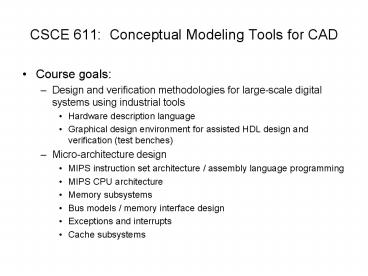CSCE 611: Conceptual Modeling Tools for CAD - PowerPoint PPT Presentation
Title:
CSCE 611: Conceptual Modeling Tools for CAD
Description:
Bus models / memory interface design. Exceptions and interrupts. Cache subsystems. Information ... 611-Conceptual Modeling Tools for CAD. ... – PowerPoint PPT presentation
Number of Views:72
Avg rating:3.0/5.0
Title: CSCE 611: Conceptual Modeling Tools for CAD
1
CSCE 611 Conceptual Modeling Tools for CAD
- Course goals
- Design and verification methodologies for
large-scale digital systems using industrial
tools - Hardware description language
- Graphical design environment for assisted HDL
design and verification (test benches) - Micro-architecture design
- MIPS instruction set architecture / assembly
language programming - MIPS CPU architecture
- Memory subsystems
- Bus models / memory interface design
- Exceptions and interrupts
- Cache subsystems
2
Information
- Catalog Description
- 611-Conceptual Modeling Tools for CAD. (3)
(Prereq CSCE 211, 245) Design techniques for
logic systems emphasis on higher-level CAD tools
such as hardware description languages and
conceptual modeling. - Textbooks and Other Required Material
- Course webpage
- Guided tutorials, manuals, lecture slides,
ISA/architecture specifications, and additional
information - Chapters 4 and 5 from HP architecture textbook
3
Outcomes
- Design large-scale digital systems using VHDL
- Perform behavioral verification using test
benches and behavioral simulation - Write and simulate programs in MIPS assembly
language using SPIM (an assembler and simulator) - Design a full microprocessor that implements the
MIPS instruction set and interfaces a memory
system
4
Topics
- Topics Covered
- VHDL digital design flow
- Design methodologies and techniques
- MIPS instruction set architecture
- Microarchitecture design
- Test bench design
- Memory models
- Bus models and interface design
- Exceptions and interrupts
- Memory hierarchy and cache subsystems
5
Course Structure
- Series of 8 lectures spanning approximately ½ of
classes - Series of 16 custom online tutorials spanning
approximately ¼ of classes - Approximately ¼ of classes spent during project
work with guidance from instructor - Lab work
- Lab 1 ALU testbench design
- Lab 2 MIPS assembly programming with SPIM
assembler/simulator - Lab 3 Multi-cycle CPU design (tested against
testbench) - Lab 4 Memory interface and bus design (tested
against significant MIPS code) - Lab 5a Exceptions and interrupts (undergraduate
students) - Lab 5b Primary cache design (graduate students)
- Final exam
- 2 hour practicum, requires design of device given
specifications - Involves FSM controller interconnected to
registers, counters, logic, etc. - Tests knowledge of test of tools
- This semester packet checksum checker
6
Student Makeup
- 11 students
- 6 graduate
- All CSE students
- 2 were formally CIS undergrads (??)
- 5 masters, 1 Ph.D.
- 5 undergraduate
- 1 taking for graduate credit
- 2 from EE, 3 from CE
- 6 As, 2 Bs, 3 Cs
7
Student Performance
8
Student Performance
9
Goals Not Met
- The original course outline included an
additional signficant project - Pipelined CPU and split primary cache
- Could not reach due to extra time needed to
present basics of assembly language programming,
ISA, archiecture, caches, etc. - Possible to move this to 212?
- FPGA implementation































